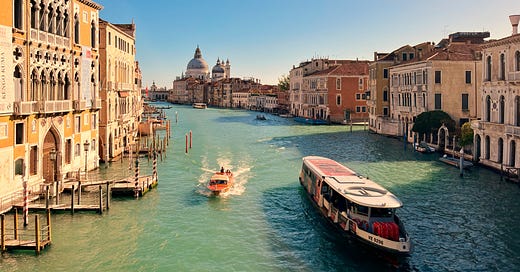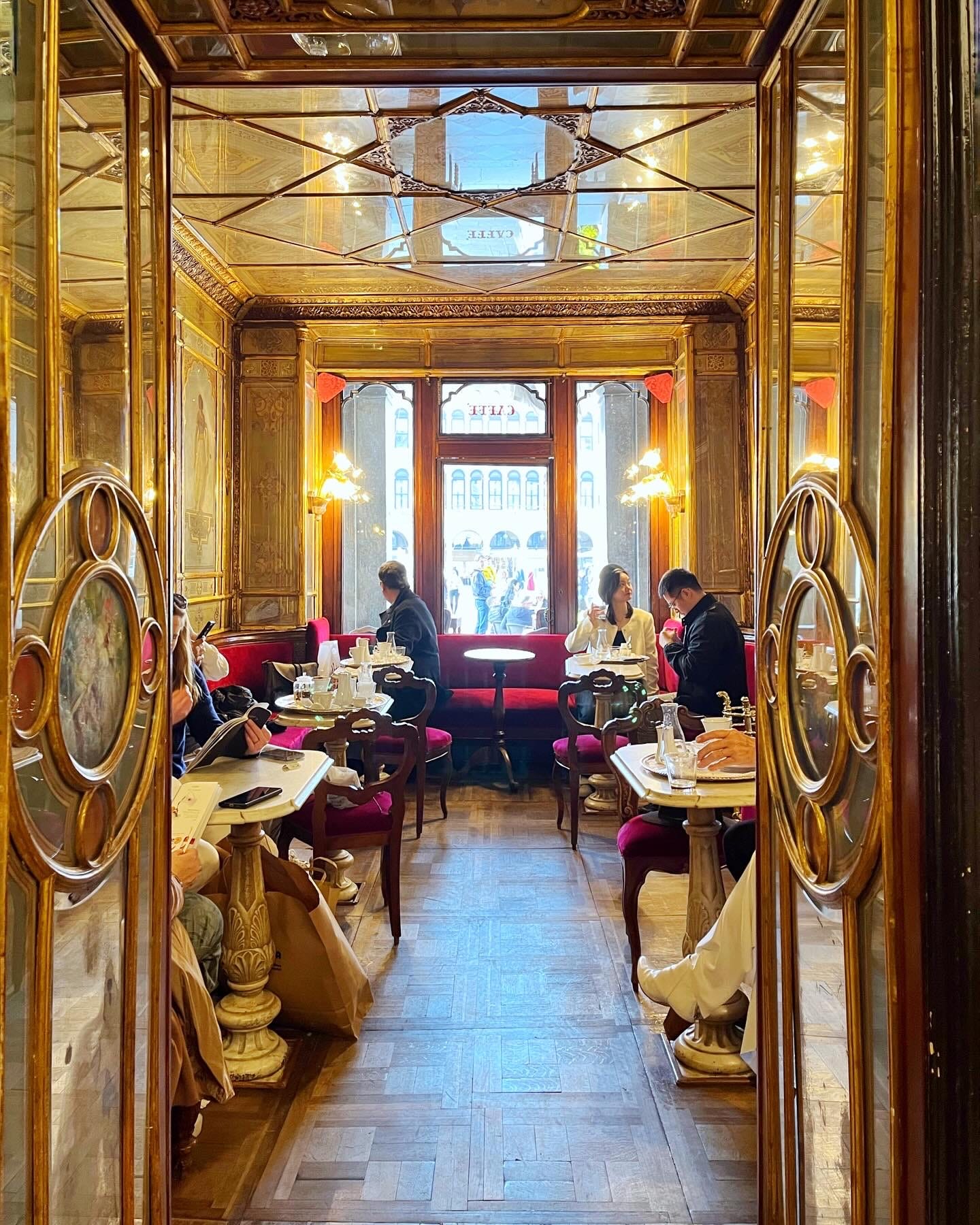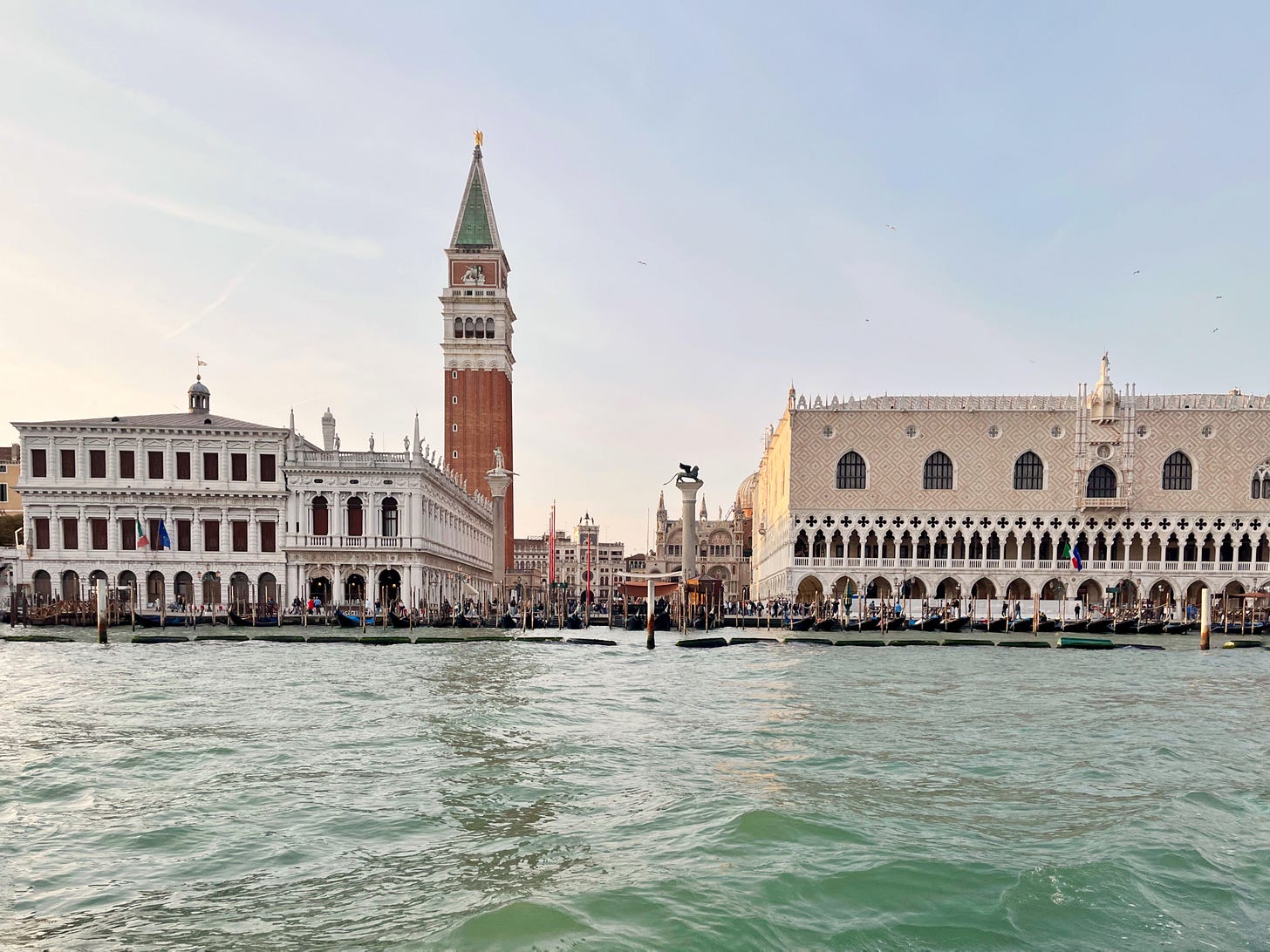Welcome to the New Roman Times’ 72 Hours series! Why 72 hours? Because the New York Times publishes a “36 Hours” series, but in my opinion, 36 hours isn’t nearly enough time to spend in Italy’s greatest cities and most compelling regions. From time to time, I’ll spotlight popular destinations like Rome, Milan, Florence, the Amalfi Coast and Capri for paid subscribers. Have a place you’d like a 72 hours guide to? Email newromantimes@substack.com or leave a comment here!
La Serenissima, the City of Canals—whatever you call it, Venice has been enchanting visitors for centuries. One of the wealthiest and most powerful maritime republics in Renaissance Europe, not to mention a stop on the Silk Route, Venice has weathered plagues and pandemics, in addition to an overtourism crisis that has spurred the local government to start imposing a €5 entry fee for day-trippers starting this month.
The first time I visited Venice—about 15 years ago—I marveled at the damask wall coverings and opulent decor at my hotel and imagined what it would be like to live in Peggy Guggenheim’s palazzo on the Grand Canal. I’ve been back at least half a dozen times since then and every time I return, I try to dig a bit deeper. On subsequent trips, I’ve cruised around the lagoon on a Riva speedboat, visited museums both large and small, gotten a behind-the-scenes peek at the workshop of artisan glassmakers, and eaten local specialties like baccalà mantecato (whipped cod served on bread or polenta), sarde in saor (sardines with sweet and sour onions, pine nuts, and raisins), and soft shell crabs at casual wine bars, fine dining restaurants, and everything in between.
Every time I return, I find there’s never enough time for everything I want to do. So believe me when I say that 72 hours is hardly enough time to spend in Venice, but it’s a good start. Here’s how to make the most of it.
DAY ONE
Venice is shaped a bit like a fish with the Grand Canal snaking through it like a backwards S. Spend your first day getting acquainted with the city on and around its most famous square, Piazza San Marco.
12 pm - Arrive and check into your hotel
Arriving at Venezia Santa Lucia station feels like an event in and of itself. Step outside and you’re directly on the Grand Canal. Splurge on a water taxi to your hotel or line up to take the vaporetto, the water buses that ply the canals.
There are hotels in Venice for every taste and budget. For Renaissance-era opulence, my favorite hotel is the Gritti Palace, a historic grand dame with damask wallpaper in the rooms and a terrace on the Grand Canal. For a boutique hotel that feels like a private home, you can’t beat the Violino d’Oro, a new member of the Leading Hotels of the World near Piazza San Marco. Just up the street is the Nolinski Venezia, which has a gorgeous library bar with floor-to-ceiling bookshelves and a ceiling mural reminiscent of Chagall.
To escape the crowds, consider staying at the Belmond Hotel Cipriani in Giudecca or the San Clemente Palace Kempinski on its own private island, which both have a boat that shuttles guests to and from Piazza San Marco. I also love the location of Sina Centurion Palace, which has views of the Grand Canal from the Dorsoduro side, which is less frenetic than Piazza San Marco.
1:30 pm - Light bite at Italy’s oldest café
Feeling hungry after the journey? Head over to Piazza San Marco and take a seat at Caffè Florian, which opened in 1720 and claims to be Italy’s oldest cafe. Inside the decor is pure Old World opulence, with gilded mirrors and velvet banquettes, while outside the tables are prime for people-watching. Yes, the food and drinks are expensive (€14 for a tramezzino and €7 for an espresso), but it’s worth it to soak up the atmosphere in this Venetian icon.
3 pm - Afternoon tour of the Doge’s Palace
Afterwards, head across the square to the Palazzo Ducale, once the seat of government and home to the doges (i.e. the city’s elite rulers). The massive pink and white marble confection is a masterpiece of Gothic architecture full of paintings by Venice’s greatest artists, including Tintoretto and Veronese. Walk across the Bridge of Sighs, which connects the palazzo to the Prigione Nuove (New Prisons) and peek inside the cramped cells where criminals were imprisoned.
Or if you’ve already visited the Palazzo Ducale and want to see a more under-the-radar place on Piazza San Marco, pop into the Negozio Olivetti, a showroom for Olivetti typewriters designed by mid-century Venetian architect Carlo Scarpa. Having ceased its function as a showroom long ago, it’s now a sort of museum run by the Fondo Ambiente Italiano, a nonprofit organization that preserves historic structures all over Italy.
6:30 pm - Aperitivo at Harry’s Bar
One of the most legendary bars not just in Venice but in all of Italy, Harry’s Bar occupies a snug wood-paneled room on a side street just off Piazza San Marco. The bar’s owner Giuseppe Cipriani invented the Bellini and it’s still made with white peach purée and Prosecco according to his recipe. A National Landmark, the bar has served illustrious guests like Ernest Hemingway, Truman Capote, Katherine Hepburn, and Peggy Guggenheim. These days you’ll encounter a mix of tourists and elegantly dressed locals.
Keep reading with a 7-day free trial
Subscribe to The New Roman Times to keep reading this post and get 7 days of free access to the full post archives.







